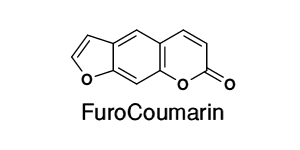| Hint | Food | 맛과향 | Diet | Health | 불량지식 | 자연과학 | My Book | 유튜브 | Frims | 원 료 | 제 품 | Update | Site |
|
독/약 ≫ 천연독 ≫ 식물독 ≫ 식물 식물독 : Furocoumarins 식물의 종류 - β-Thujone - Prussic acid - Hypericin - Goitrogens - Furocoumarins - Pyrrolizidine alkaloids - Coumarins - Safrole - Myristicin Furocoumarins represent a family of natural food constituents with phototoxic and photomutagenic properties. They are found mainly in plants belonging to the Rutaceae (e.g., citrus fruits) and Umbelliferae (e.g., parsnip, parsley, celery, carrots) families. Furocoumarins are produced in response to stress, to aid plants in defense against viruses, bacteria, fungi, insects and animals, and are regarded as natural pesticides [53]. Concentrations may also increase after exposure to UV radiation, changes in temperature, prolonged storage, or treatment with hypochlorite or copper sulfate  The three most active furocoumarins in producing photodermatitis are psoralen, 5-methoxypsoralen (5-MOP, bergapten), and 8-methoxypsoralen (8-MOP, xanthotoxin or methoxsalen) [55]. In the presence of near UV light (320–380 nm), these three linear furocoumarins can form adducts with DNA and DNA-crosslinks. The consequences of these photoadditions to cells are cell death, mutations and chromosome aberrations [54]. In the presence of ultraviolet A radiation, 5-MOP and 8-MOP produce skin tumors in experimental animals. At a chronic dose of 37.5 mg/kg bw/day in the diet, 8-MOP produces increased incidences of tubular cell hyperplasia, adenomas, and adenocarcinomas of the kidney and carcinomas of the Zymbal gland in rats [56]. Cases of skin cancer have been reported in patients treated with 8-MOP and long-wave ultraviolet light for treatment of psoriasis or mycosis fungoides [57,58]. IARC has classified 5-MOP and 8-MOP plus ultraviolet radiation in group A (probably carcinogenic in humans) and in group 1 (carcinogenic to humans), respectively [57,59]. Citrus fruits, especially grapefruit, produce a variety of chemicals in their peels that may have adverse interactions with drugs. Typically, citrus fruit juice is produced utilizing the whole fruit, including the peel. One chemical found in the peel is bergamottin (also known as bergamot), a natural furanocoumarin that is known to inhibit some isoforms of the cytochrome P450 enzyme (CYP) 3A4 [60]. Inhibition of this enzyme prevents oxidative metabolism of certain drugs, resulting in an elevated concentration of a drug in the bloodstream [61]. Bergamot and other chemicals in citrus (e.g., lime, grapefruit, orange, lemon) oils [62] are also phototoxic, causing significant toxicity to the skin when exposed to sunlight [63]. 5-Methoxypsoralen, the most phototoxic constituent of bergamot oil, showed mutagenic activity in bacterial assays and clastogenic effects in mammalian cells in culture when exposed to UV light [64]. Celery reportedly contains 100 ppb psoralens (100 micrograms/kg) and parsnips as much as 40 ppm (40 mg/kg) [65]. The estimated dietary intake of furocoumarins for people eating furocoumarin-containing foods (est. 80% of the population) is 1.31 mg/day [53], which is approximately 0.022 mg/kg bw/day for a 60 kg human. This is approximately 1000-fold lower than the 13-week dietary no observable adverse effect level (NOAEL) for liver toxicity in the rat (25 mg 8-MOP/kg bw/day) and 1700-fold lower than the dietary dose that has been shown to induce cancer in rats (37.5 mg/kg). Therefore, the risk of developing liver toxicity or cancer due to ingestion of psoralens in the diet is low. In humans, the phototoxic threshold dose of furocoumarin mixtures after dietary exposure is of the order of 10 mg 8-MOP plus 10 mg 5-MOP, which is equivalent to about 15 mg 8-MOP per person. This phototoxic threshold dose is not reached by the consumption of celery roots and other conventional vegetables under normal dietary habits, which result in intake of approximately 2–8 mg furocoumarins per person [66]. Therefore, ordinarily dietary exposure to psoralens is not considered to be a significant risk for development of photodermatitis, albeit the margin of safety is low [65]. There are no FDA regulations or guidelines specific to the presence of furocoumarins in food. |
||||
|
|
|||